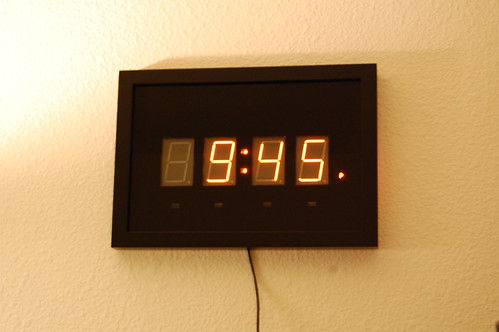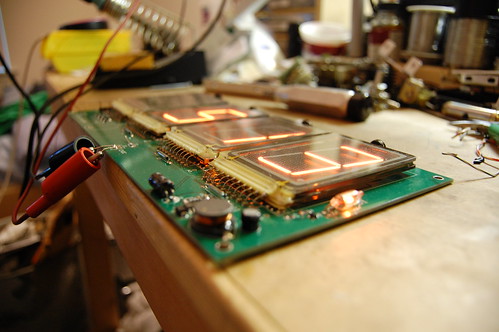Panaplex Wall Clock
October 3, 2008 10:30 pm ClocksHere are some photos of my latest clock. It uses large Panaplex-style neon-filled displays. I do not know the part numbers or the brand: these appear to be factory rejects, and each of the digits appears not to meet mechanical tolerances.

Under each digit is a reed switch that you can trigger using a magnet to change the number of that digit. The circuit board sits behind a regular picture frame where the glass has been painted black from behind. I masked off rectangular regions to allow the displays to show through, and I hand painted the “P” for the PM indication.
This is what the circuit board looks like:

The 180V power supply is on the lower right of the circuit board. The microcontroller timekeeping circuit is located underneath the leftmost digit. It is a PIC18F2420. I am using the onboard 32KHz oscillator with an external watch crystal, but I left room for a DS3231 timekeeping chip. It supports a battery backup, and you can see the place where it would go on the board right underneath the hour digits.
The left edge of the board has a row of header pins that I use to check the voltages, program the PIC in circuit, and probe the cathode voltages with a scope. The neon numerals have very interesting electrical characteristics, and eventually I will post an article about that.
Panaplex displays must be multiplexed to prevent damage. They are slightly more finicky than Nixie tubes, but the driving circuit is quite similar. I had to add a set of clamping diodes to limit the voltage swing on the cathodes (each segment is a single cathode).
This design was very fast and straightforward. I spent two evenings prototyping the circuit and getting the multiplexing working, another two evenings to enter the schematic and lay out the PC board, and two days to assemble, test, and finish the clock software.


Josef :
Date: December 10, 2008 @ 7:05 am
Hi, do you have a circuitry for a panapley power supply and technical data for panaplex display drives (SN74xxx) ?
Greets
Josef
eric :
Date: December 10, 2008 @ 11:19 pm
I will eventually post schematics for the power supply and the driver circuit. The power supply is the same one I use for Nixie clocks. You could probably use one of many designs floating around on the internet.
The driver circuit uses discrete transistors. There are some nuances with the multiplexing that I will discuss in a future post.
Tube Time » Blog Archive » Steampunk Timekeeping Instrument :
Date: February 8, 2009 @ 10:51 pm
[…] brand new limited edition (of one) Steampunk timekeeping instrument. This device is based on the Panaplex clock circuit I built a while back. The displays are seven segment but, like Nixie tubes, are filled with Neon gas. To match them, the […]
Mike :
Date: December 7, 2010 @ 5:13 pm
Eric, can you forward me some details of the driver you used for these tubes. I have a couple (NEO-5000) that i am building into a clock (not using a PIC) and would like to see how your driving them and at what voltage..
Thanks…
eric :
Date: February 23, 2011 @ 7:46 pm
You can use either transistors (MPSA42) or a Darlington driver IC (ULN2003 or ULN2803) to drive the cathodes. For the anodes, you can use PNP transistors like the MPSA92 that can handle the high voltage. The tubes pretty much have to be muxed.
Bob Armstrong :
Date: February 3, 2012 @ 8:05 pm
Eric – have you ever published the schematics or other details of this clock? I’ve got a bunch of these NEO5000 displays that I’m looking to do something with. Do you have any extra PCBs for your design that you’d like to sell? Wanna trade for an Elf2000 PCB 🙂
Thanks,
Bob Armstrong
eric :
Date: April 28, 2012 @ 7:52 pm
Bob–I just posted the schematics and assembly listing. I’m not sure if I have any extra boards, I’ll poke around.